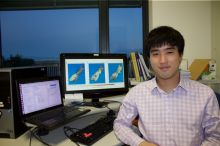Robin Lee

2017: Dr Robin Lee, University of Canterbury, has been awarded a Rutherford Foundation postdoctoral Fellowship for research entitled: ‘Earthquake-induced ground motion prediction: Realizing the shift from empirical relations to physics-based simulation methods.'
Probabilistic seismic hazard analysis is an analytical technique used to determine the probability of a specific location exceeding some level of seismic ground shaking in the future. This analysis is particularly important for the design and construction of urban structures that can withstand earthquakes, and to inform engineers of the appropriate amount of earthquake proofing required.
Currently empirical models developed from recorded ground shaking from past earthquakes are used in seismic hazard analysis for the prediction of earthquake-induced ground motions. However, their prediction precision is limited. With the rapid advance in high-performance computing, interest in physics-based alternatives has increased. Physics-based models simulate earthquake-induced ground motions through the physical laws of earthquake rupture and seismic wave propagation, with increased prediction precision. However, these new methods are not without challenges - the evolution of earthquake rupture in time and space is complex, the material composition of the Earth’s surface varies spatially, and imaging both of these is difficult due to their location below the Earth’s surface.
The 2010-2011 Canterbury earthquake sequence, and more recently, the Kaikoura earthquake, has put New Zealand researchers at the forefront of this discipline. These events provided researchers with the opportunity to validate simulated ground motions and develop models to describe the earth’s crust in different regions of New Zealand.
Dr Lee’s research aims to build on this work, and accelerate the world’s transition to physics-based ground motion simulation in probabilistic seismic hazard analysis. He will do this through extensive validation and uncertainty consideration, using New Zealand as a natural earthquake laboratory. This research has the potential to lead to a shift in the manner in which ground motions are predicted. This in turn will improve the way in which ground motion hazards are considered in the design, assessment, and resilience of the natural and built environment. Dr Lee and his team, with the aid of advanced visualization, will also use the products of this research to help increase public understanding of earthquakes and their consequences
